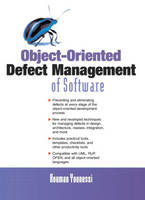
Object-Oriented Defect Management of Software
Prentice Hall (Verlag)
978-0-13-060928-1 (ISBN)
- Titel ist leider vergriffen;
keine Neuauflage - Artikel merken
This is the first systematic guide to defect identification, correction, and prevention in object-oriented software development projects. Houman Younessi covers every aspect of defect reduction, going far beyond testing to cover every key aspect of the software development process, from planning through software delivery. Younessi provides hands-on tools, templates, checklists, and other productivity tools that project team members can use to begin improving software quality immediately. The techniques presented in this book are entirely compatible with today's leading tools, notation schemes, and methodologies, including the UML modeling standard, and both the RUP (Rational Unified Process) and OPEN process models. For every developer, manager, quality professional, researcher, and student concerned with improving software quality.
HOUMAN YOUNESSI is Professor of Computer Science at Rensselaer Polytechnic Institute's Hartford Graduate Campus. A recognized authority on object technology, he created the SBM methodology and is a principal contributor and co-developer of the OPEN Process. His key research interests include software engineering processes, measurement, and defect management. Younessi is author or co-author of more than 50 publications, including two Addison Wesley books: The OPEN Process Specification and The OPEN Toolbox of Techniques.
Dedication.
Preface.
1. Setting the Scene.
Software, Software Engineering, and the Software Engineering Process. A Constructive Approach to Software Engineering. The Process of Constructing Software. Object Orientation. Understanding the Object Paradigm. Defect Management. Specifying Quality. Views of Quality. Internal Quality and External Quality: Form Complements Function. Software Product Quality Attributes. External Quality Attributes. Customer-Oriented Quality Assessment. Assessing Product Quality. Defect Management as a Means of Ensuring Quality. Achieving Quality Goals. Product Focus. The Link Between Product and Process. Process Focus. Recent Developments. Conclusion.
2. Defects and Defect Management in an Object-Oriented Environment.
Why Does Object Orientation Present Challenges in Defect Management? Abstraction. Encapsulation. Genericity. Inheritance. Multiple Inheritance. Polymorphism. Systemic Issues. Managing Defects. Opportunities for Defect Management. Defect Management Levels. Conclusion.
3. Developing Low Defect Requirements.
The Requirements Process Component. Comprehension of the Essence and Context of the ProblemúSituation or Issue at Hand. Elicitation of User Requirements. Specify Quality and Acceptance Goals. Analysis of User Requirements. Reconciliation of Requirements. Documentation of User Requirements. Requirements Narration. Usecases. The Requirements Document. The Requirements Document Set. Conclusion.
4. Identifying and Removing Requirements Defects.
Examining Conformance to Standards. Model Validation. Informal Model Evaluation. Class, Responsibility, Collaborator (CRC) Approach. Formal Model Validation. Requirements Document Inspection. Conclusion.
5. Preventing Design Defects.
Software Design. Design for Functionality. Design for Reliability. Design for Usability. Design for Maintainability. Design for Process Efficiency. Basic Elements of Good Design. Cohesion: A Measure for Modularity. Coherence: Another Measure for Modularity. Coupling: Another Measure for Minimality of Interaction and for Segregation. Achieving Segregation. Achieving Abstraction. Achieving Multiple Levels of Granularity. Achieving Formality. Achieving Anticipation of Invalid States (Exception Handling). Achieving Redundancy. Achieving Genericity. Architecture. Distribution: Distributed Topology. Architectural Design Styles. Styles of Control. Solving Specific Architectural Problems. Basic Steps for Architectural Design. Design Reviews. Architectural (System) Design Documentation. Object Design. Conclusion.
6. Design Defect Identification.
Design Defects. Identifying Defects in Design. Design Simulation. Design Inspection. Inspecting Design Artifacts. Class Diagram. Sequence Diagrams. Collaboration Diagrams. State Diagrams. Activity Diagram. Transformational Description. Module or Package Diagram. Implementation or Component Diagram. Deployment Diagrams. Identifying Defects in a Design. Document. Conclusion.
7. Program Defect Identification.
Defect Indentification Techniques. Evaluation. Education and Examination of Alternatives. Defect Identification. Comparing Inspection and Testing (Failure Detection). Inspecting Object-Oriented Code. Failure Detection-Oriented Defect Removal. Testing Object-Oriented Code. Conclusion.
8. Testing Classes.
Testing Base Classes. Testing for Correct Generation of Instances. Testing for Correct Attribute Values. Testing if Routines Correctly Alter the Representation of the Corresponding Object. Assertion-Based Testing of a Class. Class Invariants and Assertions at the Class Level. Constraint-Based or Assertion Constraint Coverage-Based Testing. Modal Testing of a Class. State Invariants. Modal Testing. Transformational Testing of Methods. Partitioning or Subdomain Testing. A Comparison of the Effectiveness of Subdomain-Based and Statistically Based Approaches. Conclusion.
9. Integration, Integration Testing, and System Testing.
Components and Integration. Component Interaction. Integration Strategies. Integration Testing Techniques. Scenario Testing. Modal Testing. System Testing. Usecase-Based Testing. System Temporal Boundary Testing. Performance and Load Testing. Usability Testing. System Acceptance. Beta Testing. Identify a Purpose for Beta Testing. Select Your Site Carefully. Decide What to Do Next. Conclusion.
Appendix A. Taxonomy of Defect Management.
Appendix B. Syntax of Object Z.
Appendix C. Software Inspection Process.
1. Inspection Process Script. Script I-2X Inspection Process Scripts. Author's or Author's Proxy's Task Scripts. Moderator's Task Scripts. Reader's Task Scripts. Scribe's Task Scripts. Other Inspector's Task Scripts. Script I-1 Definitions. Script I-6 Moderator's Inspection Meeting Agenda. Script I-2S Specification Inspection Process Script. Script I-2D Design Inspection Process Script. Script I-2C Code Inspection Process Script. Script I7-S Specification Inspection Checklist. Script I7-D Design Inspection Checklist. Script I7-C Code Inspection Checklist.
References.
Index.
| Erscheint lt. Verlag | 22.4.2002 |
|---|---|
| Verlagsort | Upper Saddle River |
| Sprache | englisch |
| Gewicht | 930 g |
| Themenwelt | Informatik ► Software Entwicklung ► Objektorientierung |
| Informatik ► Weitere Themen ► Hardware | |
| ISBN-10 | 0-13-060928-5 / 0130609285 |
| ISBN-13 | 978-0-13-060928-1 / 9780130609281 |
| Zustand | Neuware |
| Haben Sie eine Frage zum Produkt? |
aus dem Bereich


